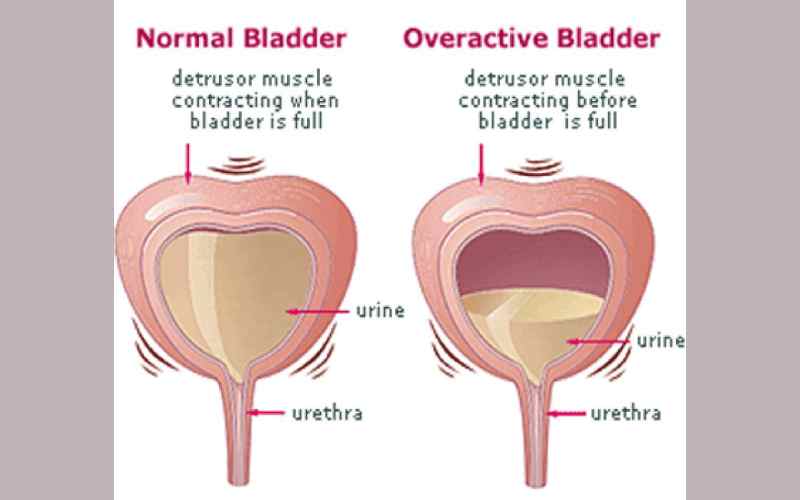
Overactive bladder describes a combination of chronic and bothersome urinary symptoms such as abrupt, uncontrolled urge to urinate, possible urine leaks and going to the bathroom many times during the day and night. Research published on PubMed estimates that nearly 17 per cent of the overall adult population experience OAB. The International Continence Society describes the urinary urgency as so strong to ignore. Majority of the patients who suffer from OAB are of advanced age. Most of the time, these patients show no sign of an obvious underlying issue such as urinary tract infection, urinary incontinence or metabolic disorders that affect urination.
How does it happen?
Usually, the brain signals you when your bladder is filling up. A healthy bladder can normally hold on for some time before it fills up and you really have to go to the bathroom. When the bladder fills up, the brain signals the bladder muscles to squeeze. The squeezing effect allows urine waste into the urethra. The urethral sphincter/valve opens to allow urine to flow out. On the other hand, the bladder muscles relax when it isn’t full. A person experiencing OAB will feel an urgent need to urinate even when the bladder is not full. The need is sudden and they cannot hold it back. Sometimes, individuals may not be able to make to the bathroom before urination.
Effect on the quality of life
OAB occurs in both men and women and it carries a tremendous effect of the quality of life. Frequent urination—which Pathologists Lancet Kenya explains as going to the bathroom more than eight times in 24 hours-- will obviously interfere with performance of day to day activities such as work, travelling and even sexual function. It even decreases sleep quality when you have to wake up more than once to pee, a symptom otherwise known as nocturia. Nocturia can also happen after drinking too much liquid close to bed time or due to pregnancy. Additionally, OAB may increase psychological stress due to embarrassment, frustration and anxiety since it limits social engagements. This causes many patients to suffer in silence without seeking medical attention. In fact, the Kenya Association of Urological Surgeons, KAUS estimates that, “60-80 per cent of these patients do not seek advice for their condition; 35 per cent only viewing it as part of the natural ageing process.”
What causes OAB?
Benign prostate hyperplasia, also called enlarged prostate is one of the most common causes of OAB in men. The growing size of the prostate may disrupt urine flow out of the urethra. Enlarged prostate is responsible for approximately two thirds of men with OAB. This is according to the Urology Associates. In women, prolapse of pelvic organs, uterine fibroids and hernias have been implicated to interfere with bladder emptying. Other causes may include; pelvic weakness, weak bladder muscles, bladder stones, obesity, diet, constipation, uncontrolled diabetes and neurological conditions that may interfere with the signals between your brain and bladder such as Parkinson’s disease, stroke and multiple sclerosis. Malfunctioning of nerves and bladder muscles triggers sensations that cause unnecessary contraction of bladder muscles to bring about the uncontrollable urge to urinate.
Treatment
OAB is manageable. One needs to see a doctor for accurate diagnosis and treatment. Urologists at KAUS advise that a patient is expected to share a detailed medical history of the condition including obstetric history, fluid intake, bowel function, drug usage among others. You may be asked to keep a bladder diary for a couple of days. Abdominal, vaginal and rectal exams may be performed to feel any enlarged masses or prolapsed organs. Neurological examinations may also be performed for assessment of reflexes.
Simple physical therapy measures to help in management include losing excess weight, conducting pelvic flow exercises my alleviate some of the symptoms. Since many risk factors for OAB are modifiable, lifestyle changes could make a difference in managing the symptoms. Bladder training by delaying urination or scheduling set times to do so supplement treatment options. Drugs and in some cases, surgery may be recommended for treatment. Furthermore, electrical stimulation has been published to have a greater reduction of OAB symptoms.
Nancy Nzalambi is a research scientist with NHIF
 The Standard Group Plc is a
multi-media organization with investments in media platforms spanning newspaper
print operations, television, radio broadcasting, digital and online services. The
Standard Group is recognized as a leading multi-media house in Kenya with a key
influence in matters of national and international interest.
The Standard Group Plc is a
multi-media organization with investments in media platforms spanning newspaper
print operations, television, radio broadcasting, digital and online services. The
Standard Group is recognized as a leading multi-media house in Kenya with a key
influence in matters of national and international interest.
 The Standard Group Plc is a
multi-media organization with investments in media platforms spanning newspaper
print operations, television, radio broadcasting, digital and online services. The
Standard Group is recognized as a leading multi-media house in Kenya with a key
influence in matters of national and international interest.
The Standard Group Plc is a
multi-media organization with investments in media platforms spanning newspaper
print operations, television, radio broadcasting, digital and online services. The
Standard Group is recognized as a leading multi-media house in Kenya with a key
influence in matters of national and international interest.







